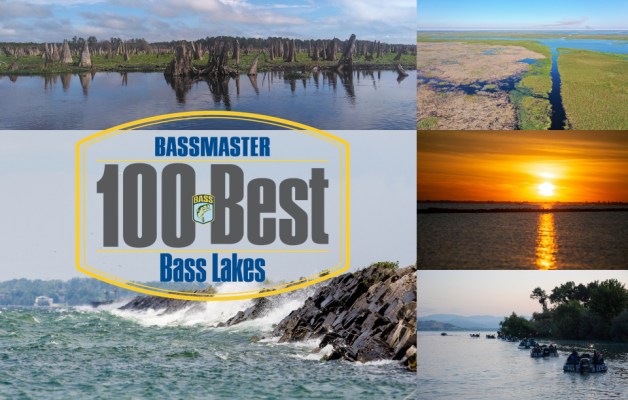![<h4>1. Clear Lake, California</h4><br>
[43,785 acres] The Golden Stateâs largest natural lake remains one of the best largemouth factories in the country. Home to more trophy bass in the 6- to 10-pound class than any other body of water in the West, it provides opportunities for both limits and individual fish of a lifetime. It took five bass weighing 30.92 pounds to win a Best Bass Tournament Trail team event in April. And there were 29 bass over 7 pounds brought to the scales at the WON Bass California Open that same month. Ten-pound fish took big bass honors at both events.](http://www.bassmaster.com/wp-content/uploads/2018/10/bbl_w_01_clearlake_2018.jpg)
[43,785 acres] The Golden Stateâs largest natural lake remains one of the best largemouth factories in the country. Home to more trophy bass in the 6- to 10-pound class than any other body of water in the West, it provides opportunities for both limits and individual fish of a lifetime. It took five bass weighing 30.92 pounds to win a Best Bass Tournament Trail team event in April. And there were 29 bass over 7 pounds brought to the scales at the WON Bass California Open that same month. Ten-pound fish took big bass honors at both events.
![<h4>2. Diamond Valley Lake, California</h4><br>
[4,500 acres] The California Department of Fish and Wildlifeâs efforts to create yet another south-state trophy fishery is paying off with regular reports of heavy limits. The near-pure Florida-strain largemouth stocked as the reservoir was filled for the first time are flourishing. Anglers had to catch 5-pound averages to win National Bass West team tournaments in February, March and April. Big fish at the three events were 9.41, 10.34 and 7.10 pounds, and there were 60 bass weighed topping 5 pounds at the three contests combined.](http://www.bassmaster.com/wp-content/uploads/2018/10/bbl_w_02_diamondvalleylake_diamond_valley_2_2018.jpg)
[4,500 acres] The California Department of Fish and Wildlifeâs efforts to create yet another south-state trophy fishery is paying off with regular reports of heavy limits. The near-pure Florida-strain largemouth stocked as the reservoir was filled for the first time are flourishing. Anglers had to catch 5-pound averages to win National Bass West team tournaments in February, March and April. Big fish at the three events were 9.41, 10.34 and 7.10 pounds, and there were 60 bass weighed topping 5 pounds at the three contests combined.
![<h4>3. Sacramento-San Joaquin Delta, California</h4><br> [1,100 square miles] California sea lions are being found in increasing numbers throughout the Deltaâs network of rivers, sloughs and flooded islands, and some feel theyâre the reason for decreasing numbers of big largemouth. But even with fewer trophy bass reports, regardless of the reason, competitive anglers continue to weigh respectable numbers of quality fish. An American Bass contest held April 7 was won with 27.04 pounds. There were a dozen largemouth over 5 pounds, including a 10.09 tournament big fish.](http://www.bassmaster.com/wp-content/uploads/2018/10/bbl_w_03_sacramentosanjoaquindelta_150430srca0655_bass_seven_seas_creations_ink._seigo_saito_2018.jpg)
![<h4>4. New Melones Lake, California</h4><br> [12,500 acres] When the U.S. Army Corps of Engineers built New Melones, the fourth-largest reservoir by volume in the state, no one thought it would fill. And although itâs not quite there yet, water levels are well above historical averages following consecutive years of decent precipitation. Big bass during a February California Tournament Trail event weighed 10.85 pounds.](http://www.bassmaster.com/wp-content/uploads/2018/10/bbl_w_04_newmeloneslake_20170418_185701_2018.jpg)
![<h4>5. Don Pedro Reservoir, California</h4><br> [13,000 acres] This Tuolumne River impoundment, in the Sierra foothills, is ignored by lots of people heading to Yosemite National Park. Anglers sure know what this huge reservoir holds: some of the biggest bass in the state. There were three fish over 8 pounds caught at a Wild West Bass Trail pro/am in March. And the amateurs caught two of them, including the 9.67 big fish.](http://www.bassmaster.com/wp-content/uploads/2018/10/bbl_w_05_donpedroreservoir_don_pedro_5_2018.jpg)
![<h4>6. Lake Berryessa, California</h4><br> [20,700 acres] Despite a slow start to the rain this past year, March was wet enough to keep most Western reservoirs in good shape. That was the case at Berryessa, which, according to some, made finding the lakeâs biggest bass a bit difficult. But there were still enough quality largemouth, smallmouth and spots caught to rank this Bay Area jewel high. In March, it took 22.01 pounds, anchored by a 10.13 kicker, to win a Future Pro Tour contest.](http://www.bassmaster.com/wp-content/uploads/2018/10/bbl_w_06_lakeberryessa_berryessa_2_2018.jpg)
![<h4>7. Lake Havasu, Arizona/California</h4><br> [19,300 acres] Fun in the sun is the best way to define this Colorado River reservoir, affectionately deemed âArizonaâs Playground.â And fishing is at the top of our fun things to do list, thanks to big largemouth and smallies. There were 18 bass over 5 pounds caught during a March Wild West Bass Trail pro/am.](http://www.bassmaster.com/wp-content/uploads/2018/10/bbl_w_07_havasu_2018_ja.jpg)
![<h4>8. Roosevelt Lake, Arizona</h4><br> [21,493 acres] Eighty miles from Phoenix, on the Salt River, Theodore Roosevelt Dam creates what was at one time the largest man-made lake in the world. Although it can no longer make that claim, it is due the title of big-bass producer thanks to the Arizona Game and Fish Departmentâs habitat enhancement and stocking program â another 25,000 pounds of Florida-strain largemouth were planted in April. Big fish at an Arizona B.A.S.S. Nation event in March was a giant 9-4.](http://www.bassmaster.com/wp-content/uploads/2018/10/bbl_w_08_rooseveltlake_dsc_2623_2018.jpg)
![<h4>9. Lake Perris, California</h4><br> [2,250 acres] Max Fish and Monty Currier, both environmental scientists with the California Department of Fish and Wildlife, rank Perris the fourth-best bass fishery in the state. The department has been working during a decade-long emergency drawdown to install brush, pipe caves and rock reefs to increase fish habitat. It took only four bass weighing 17.55 to win an American Bass event in January.](http://www.bassmaster.com/wp-content/uploads/2018/10/bbl_w_09_lake_perris_2018.jpg)
![<h4>10. Tenmile Lake, Oregon</h4><br> [1,626 acres] Bass arenât the first thing that comes to mind when someone mentions Pacific Northwest coastal lakes. Tenmile was, in fact, known for salmon, steelhead and cutthroat trout back in the day. But watershed alterations changed all that, turning it into the stateâs best largemouth fishery. Today, itâs almost common to see bass topping 5 pounds. There were six over 5, include two 7-pounders, at the Emerald Bass Clubâs 22nd annual Frostbite Open in February.](http://www.bassmaster.com/wp-content/uploads/2018/10/bbl_w_10_tenmilelake_tenmile_8_2018.jpg)
![<h4>11. Lake Mohave, Nevada/Arizona</h4><br> [26,500 acres] Following the southern Nevada and northwestern Arizona border, this Colorado River impoundment is narrow and shallow in contrast to Lake Mead. Sheer canyon walls upstream and wider downstream areas provide a variety of habitat that striped, largemouth and smallmouth bass take advantage of. It took 21 pounds to win an Ultimate Bass Team Tour event here in March.](http://www.bassmaster.com/wp-content/uploads/2018/10/bbl_w_11_mohave_mohave_supervisor_john_rolle_on_strip_2018.jpg)
![<h4>12. Lake Pleasant, Arizona</h4><br> [12,040 acres] New Waddell Dam is on the Agua Fria River, but most of the water here is diverted from the Colorado. When built to increase Phoenix supplies, there were concerns about potential fishery impacts. And although Arizona Game and Fish studies show decreases in productivity, cover and bass numbers, anglers are catching bigger fish. Average sizes arenât special, but when you hook a trophy, you know it. Big fish at a March Wild West Bass team tournament was 10-4.](http://www.bassmaster.com/wp-content/uploads/2018/10/bbl_w_12_pleasant_gfd_0030_2018.jpg)
![<h4>13. Potholes Reservoir, Washington</h4><br> [27,800 acres] Water levels fluctuate seasonally at this Columbia Basin Irrigation Project impoundment. And although that can make fishing tough, itâs a boon to bass habitat. Willows flourish when the 1,000-plus submerged islands are exposed during low water. When the reservoir rises and inundates the trees, it makes ideal largemouth cover. At an April Potholes Bass Club two-day contest, there were 859 largemouth to 65 smallies, with 14 of the former over 5 pounds.](http://www.bassmaster.com/wp-content/uploads/2018/10/bbl_w_13_potholesreservoir_dsc_0877_2018.jpg)
![<h4>14. Fort Peck Reservoir, Montana</h4><br> [245,000 acres] This is Montanaâs largest body of water and the fifth-largest reservoir in the country by volume. And according to Montana B.A.S.S. Nation Conservation Director Don Collins, this Missouri River impoundment is the stateâs best bass fishery, too. The Montana smallmouth record was set here on Sept. 13, 2017, when Mike Dominick caught and released a massive 7.5-pound fish.](http://www.bassmaster.com/wp-content/uploads/2018/10/bbl_w_14_fortpeckreservoir_jbartlett-july2016-usa-montana-glasgow-0331_2018.jpg)
![<h4>15. Lake Coeur dâAlene, Idaho</h4><br> [31,487 acres] Despite short growing seasons due to altitude and cold waters, Coeur dâAleneâs bass get big. Five 5.5- to 7.25-pound fish were weighed at an American Bass contest in April.](http://www.bassmaster.com/wp-content/uploads/2018/10/bbl_w_15_coeurdalene_2018.jpg)
![<h4>16. Lake Washington, Washington</h4><br> [21,934 acres] This is the stateâs second-largest natural lake, and there is more than enough habitat to keep bass populations healthy. Smallmouth outnumber largemouth, and there are big fish of each, but tournament winners usually have at least one of the green variety. It took 21.95 pounds to win a March American Bass event.](http://www.bassmaster.com/wp-content/uploads/2018/10/bbl_w_16_lakewashington_lk_washington_aerial_2018.jpg)
![<h4>17. Dworshak Reservoir, Idaho</h4><br> [17,090 acres] Kokanee numbers have been falling here since 2015. And less high-protein forage for the huge smallmouth that Dworshak is known for means not as many trophies. Resource agencies are now supplementing nutrients in hopes of producing more of the small salmon. A 6.07-pound smallie was needed to win big bass at a Clearwater Bass Anglers contest in April.](http://www.bassmaster.com/wp-content/uploads/2018/10/bbl_w_17_dworshakreservoir_2018.jpg)
![<h4>18. Saguaro Lake, Arizona</h4><br> [1,264 acres] Nestled in the Tonto National Forest, less than an hourâs drive from Mesa, this rock-dominated reservoir is known for big largemouth. The quality can be attributed, in part, to the departmentâs trout stocking program that keeps bass well fed. It took 19.81 pounds to win a February Arizona Bass Federation qualifier. Big fish at that one was 7.25.](http://www.bassmaster.com/wp-content/uploads/2018/10/bbl_w_18_saguarolake_gfd_0572_2018.jpg)
![<h4>19. Lake Powell, Utah/Arizona</h4><br> [108,335 acres] Smallmouth and largemouth populations here benefited from last yearâs rising water levels and newly flooded brush. The lengthy drought, however, isnât over, and the region is again seeing well-below-average precipitation. So far, the lack of water isnât impacting bass. During four team events this spring, 74 percent of the bags weighed contained limits.](http://www.bassmaster.com/wp-content/uploads/2018/10/bbl_w_19_lakepowell_2013-07-23-11-32-28-755_waynegustaveson_2018.jpg)
![<h4>20. C.J. Strike Reservoir, Idaho</h4><br> [6,759 acres] This high desert reservoir, on the Snake and Bruneau rivers, is operated for power generation. As a result, water levels remain relatively stable, which leads to good bass recruitment and consistent fishing. Smallmouth dominate here, but it often takes one or two largemouth to win a tournament. It took 18 pounds to finish in the Top 4 at a Magic Valley Bassmasters event in March. Big bass was a 6.51-pound largemouth, while the second-biggest fish was a 4.22 smallie.](http://www.bassmaster.com/wp-content/uploads/2018/10/bbl_w_20_cjstrikereservoir_2018.jpg)
![<h4>21. Elephant Butte Reservoir, New Mexico</h4><br> [36,500 acres] Elephant Butteâs recovery from multiple low-water years, which severely impacted bass populations, continues. The bad news is improvements are likely due to stable low levels â not more water. But thereâs good news, too. The larger bass that it was once known for are starting to show up again. There were two fish over 6 pounds at an American Bass contest in April, with the largest one going 7.47.](http://www.bassmaster.com/wp-content/uploads/2018/10/bbl_w_21_elephantbuttereservoir_butte1_2018.jpg)
![<h4>22. Siltcoos Lake, Oregon </h4><br> [3,164 acres] The location of this Pacific Northwest coastal lake, at only 13 feet above sea level and 3 miles from the ocean, make it an unlikely candidate on a list of the nationâs best bass factories. Siltcoosâ shallow, nutrient-rich waters, however, create ideal conditions for vegetation. All-Star Bass Fishingâs Bass Battles contest in March was won with 16.68 pounds. The big fish was a 7-12.](http://www.bassmaster.com/wp-content/uploads/2018/10/bbl_w_22_siltcooslake_2018.jpg)
![<h4>23. Lake Mead, Nevada/Arizona</h4><br> [158,080 acres] Drought conditions are back throughout the Colorado River region after a short one-year reprieve. The lack of rain means Mead may drop by up to 11 feet by the end of 2018. But low water isnât expected to impact fishing. Nevada Department of Wildlife staff specialist Patrick Sollberger still rates it as the stateâs best bass fishery. It took 17.55 pounds to win American Bassâ Pat Donoho Memorial event in April.](http://www.bassmaster.com/wp-content/uploads/2018/10/bbl_w_23_mead_2018_ja.jpg)
![<h4>24. Tahkenitch Lake, Oregon</h4><br> [2,118 acres] As the last remaining large, undeveloped, coastal lake in Oregon, Tahkenitch doesnât get a lot of tournament pressure. But those who do make the trip are typically rewarded with quality fishing. Although not known as a trophy producer, it has lots of quality largemouth. An American Bass contest in April was won with 19.51 pounds.](http://www.bassmaster.com/wp-content/uploads/2018/10/bbl_w_24_tahkenitchlake_166_five_mile_arm_lake_tahkenitch_munsel_odfw_2018.jpg)
![<h4>25. Columbia River, Oregon/Washington </h4><br> [191 miles from Portland to McNary Dam] The mighty Columbia and both salmon and steelhead go hand-in-hand and define a rich Pacific Northwest fishing history. And despite attempts to reduce bass numbers by removing the bag limits, there are still lots of big smallmouth to be had. It took 19.12 to win a Columbia River Bassmaster tournament in April.](http://www.bassmaster.com/wp-content/uploads/2018/10/bbl_w_25_columbiariver_col_r_2_2018.jpg)




